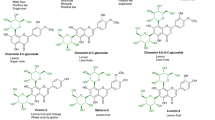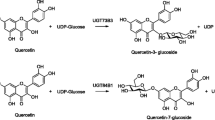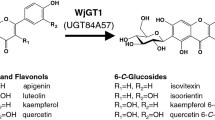Abstract
A cDNA encoding UDP-glucose: formononetin 7-O-glucosyltransferase, designated UGT73F1, was cloned from yeast extract-treated Glycyrrhiza echinata L. cell-suspension cultures using probes from Scutellaria baicalensis UDP-glucose: flavonoid 7-O-glucosyltransferase. The open reading frame of the UGT73F1 cDNA encodes a 441-amino-acid protein with a predicted molecular mass of 48.7 kDa. The deduced amino acid sequence showed that the protein is related to the stress-inducible glucosyltransferases. UGT73F1 mRNA was not detected in untreated G. echinata cultures but was transiently induced by treatment with yeast extract. Recombinant UGT73F1 was expressed as a histidine-tag fusion protein in Escherichia coli and purified to near homogeneity by nickel chelate chromatography. The purified recombinant enzyme was selective for isoflavonoid, formononetin and daidzein as substrates, while flavonoids and various tested non-flavonoid compounds were poor substrates.



Similar content being viewed by others
Abbreviations
- GT:
-
UDP-glycosyltransferase
- rUGT73F1:
-
recombinant UGT73F1
- UBGT: UDP-glucose::
-
baicalein 7-O-glucosyltransferase
References
Ayabe S, Furuya T (1982) Studies on plant tissue cultures. Part 36. Biosynthesis of a retrochalcone echinatin, and other flavonoids in the cultured cells of Glycyrrhiza echinata. A new route to a chalcone with transposed A- and B-rings. J Chem Soc Perkin Trans 1:2725–2734
Ayabe S, Iida K, Furuya T (1986) Stress-induced formation of echinatin and a metabolite, 5′-prenyl-licodione, in cultured Glycyrrhiza echinata cells. Phytochemistry 25:2803–2806
Dewick PM (1993) Isoflavonoids. In: Harborne JB (ed) The flavonoids: advances in research since 1986. Chapman & Hall, London, pp 117–238
Dixon RA, Canovas P, Guo Z-J, He X-Z, Lamb C, McAlister F (1999) Molecular controls for isoflavonoid biosynthesis in relation to plant and human health. In: Romeo JT (ed) Recent advances in phytochemistry: phytochemicals in human health protection, nutrition, and plant defense. Kluwer/Plenum, New York, pp 133–183
Fraissinet-Tachet L, Baltz Rachel, Chong J, Kauffmann S, Fritig B, Saindrenan P (1998) Two tobacco genes induced by infection, elicitor and salicylic acid encode glucosyltransferases acting on phenylpropanoids and benzoic acid derivatives, including salicylic acid. FEBS Lett 437:319–323
He XZ, Dixon RA (2000) Genetic manipulation of isoflavone 7-O-methyltransferase enhances biosynthesis of 4′-O-methylated isoflavonoid phytoalexins and disease resistance in alfalfa. Plant Cell 12:1689–1702
He XZ, Reddy JT, Dixon RA (1998) Stress response in alfalfa (Medicago sativa L.) XXII. cDNA cloning and characterization of an elicitor-inducible isoflavone 7-O-methyltransferase. Plant Mol Biol 36:43–54
Hirotani M, Kuroda R, Suzuki H, Yoshikawa T (2000) Cloning and expression of UDP-glucose: flavonoid 7-O-glucosyltransferase from hairy root cultures of Scutellaria baicalensis. Planta 210:1006–1013
Horvath DM, Chua NH (1996) Identification of an immediate-early salicylic acid-inducible tobacco gene and characterization of induction by other compounds. Plant Mol Biol 31:1061–1072
Hughes J, Hughes MA (1994) Multiple secondary plant product UDP-glucose glucosyltransferase genes expressed in cassava (Manihot esculenta Crantz) cotyledons. DNA Seq 5:41–49
Jones P, Vogt T (2001) Glycosyltransferases in secondary plant metabolism: tranquilizers and stimulant controllers. Planta 213:164–174
Li Y, Baldauf S, Lim E-K, Bowles DJ (2001) Phylogenetic analysis of the UDP-glycosyltransferase multigene family of Arabidopsis thaliana. J Biol Chem 276:4338–4343
Mackenzie PI, Owens IS, Burchell B, Bock KW, Bairoch A, Bélanger A, Fournel-Gigleux S, Green M, Hum DW, Iyanagi T, Lancet D, Louisor P, Magdalow J, Chowdhury JR, Ritter JK, Schachter H, Tephly TR, Tipton KF, Nebert DW (1997) The UDP glycosyltransferase gene superfamily: recommended nomenclature update based on evolutionary divergence. Pharmacogenetics 7:255–269
Moehs CP, Allen PV, Friedman M, Belknap WR (1997) Cloning and expression of solanidine UDP-glucosyltransferase from potato. Plant J 11:227–236
Murashige T, Skoog F (1962) A revised medium for rapid growth and bio assays with tobacco tissue cultures. Physiol Plant 15:473–497
Nakaura K, Akashi T, Aoki T, Kawaguchi K, Ayabe S (1999) Induction of isoflavonoid and retrochalcone branches of the flavonoid pathway in cultured Glycyrrhiza echinata cells treated with yeast extract. Biosci Biotechnol Biochem 63:1618–1620
Ross J, Li Y, Lim E-K, Bowles D (2001) Higher plant glycosyltransferases. Genome Biol 2: reviews3004.1–reviews3004.6
Saitou N, Nei M (1987) The neighbor-joining method: a new method for reconstructing phylogenetic trees. Mol Biol Evol 4:406–425
Sambrook J, Russell DW (2001) Molecular cloning: a laboratory manual. Cold Spring Harbor Laboratory Press, Cold Spring Harbor, NY
Taguchi G, Yazawa T, Hayashida N, Okazaki M (2001) Molecular cloning and heterologous expression of novel glucosyltransferases from tobacco cultured cells that have broad substrate specificity and are induced by salicylic acid and auxin. Eur J Biochem 268:4086–4094
The Arabidopsis Genome Initiative (2000) Analysis of the genome sequence of the flowering plant Arabidopsis thaliana. Nature 408:796–815
Thompson JD, Gibson TJ, Plewniak F, Jeanmougin F, Higgins DG (1997) The ClustalX windows interface: flexible strategies for multiple sequence alignment aided by quality analysis tools. Nucleic Acids Res 24:4876–4882
Vogt T, Jones P (2000) Glycosyltransferases in plant natural product synthesis: characterization of a supergene family. Trends Plant Sci 5:380–386
Zhang J, Madden TL (1997) PowerBLAST: a new network BLAST application for interactive or automated sequence analysis and annotation. Genome Res 7:649–656
Acknowledgments
The authors thank Prof. S. Ayabe for supplying the G. echinata callus and the cDNA library. This research was funded by a Sasakawa Scientific Research Grant from the Japan Science Society and by a Kitasato University Research Grant for Young Researchers.
Author information
Authors and Affiliations
Corresponding author
Additional information
The nucleotide sequence data reported in this paper will appear in the DDBJ/EMBL/GenBank nucleotide sequence databases with the accession number AB098614.
Rights and permissions
About this article
Cite this article
Nagashima, S., Inagaki, R., Kubo, A. et al. cDNA cloning and expression of isoflavonoid-specific glucosyltransferase from Glycyrrhiza echinata cell-suspension cultures. Planta 218, 456–459 (2004). https://doi.org/10.1007/s00425-003-1118-0
Received:
Accepted:
Published:
Issue Date:
DOI: https://doi.org/10.1007/s00425-003-1118-0




